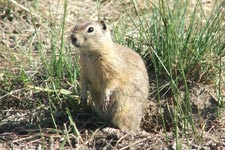Local Wildlife
Belding's Ground Squirrel

Scientific Name: Spermophilus beldingi
Addt'l Info: Univ. of Michigan
The Belding's ground squirrel is smaller than most of it's tree-living cousins and larger than the golden-mantled ground squirrel. It's fur is a sandy gray with hints of black and cinnamon. The chest is a more consistent beige and the head is comprised of darker hairs. It's ears are small compared to other squirrels and it's tail is short and small (a common characteristic of ground squirrels in general). These rodents are sometimes confused with the black-tailed prairie dog because both live in colonies comprised of various burrows, have small ears, and have relatively small, short-haired tails.
These quick little creatures inhabit the alpine grasslands and meadows from eastern Oregon to western Utah. They are moderately sociable animals that live in (sometimes large) colonies. However, the colony is not a collective, but rather a collection of individual or familial burrows. Active in the morning and evening, your best chance to observe them is to take one of the paths that run along or through the great meadow bounded by the river, Lake Aspen, the airport, and the Meadows golf course sometime between two hours after sunrise and two hours before sunset.
The diet of this ground squirrel is comprised of mostly grasses, weeds, roots, seeds, and small plants native to their habitat. However, when faced with starvation, they may resort to insects, carrion, and even their own young. They do not drink, deriving the moisture they need from what they eat. The loose earth around their burrows (a result of their digging) provides an excellent environment for the growth of their food sources.
Belding's ground squirrels breed in late May through early June and have their young roughly a month later. Litter size can range from 1 to 11 with one litter per year. Juveniles emerge from their burrow for the first time about a month after birth. It is commonly believed that these squirrels (along with prairie dogs) damage the rangelands used for livestock, but further study suggests that they are not the cause, but the result. Areas damaged by overgrazing offer a number of features that attract ground squirrel and/or prairie dog populations, leading to the erroneous correlation.
